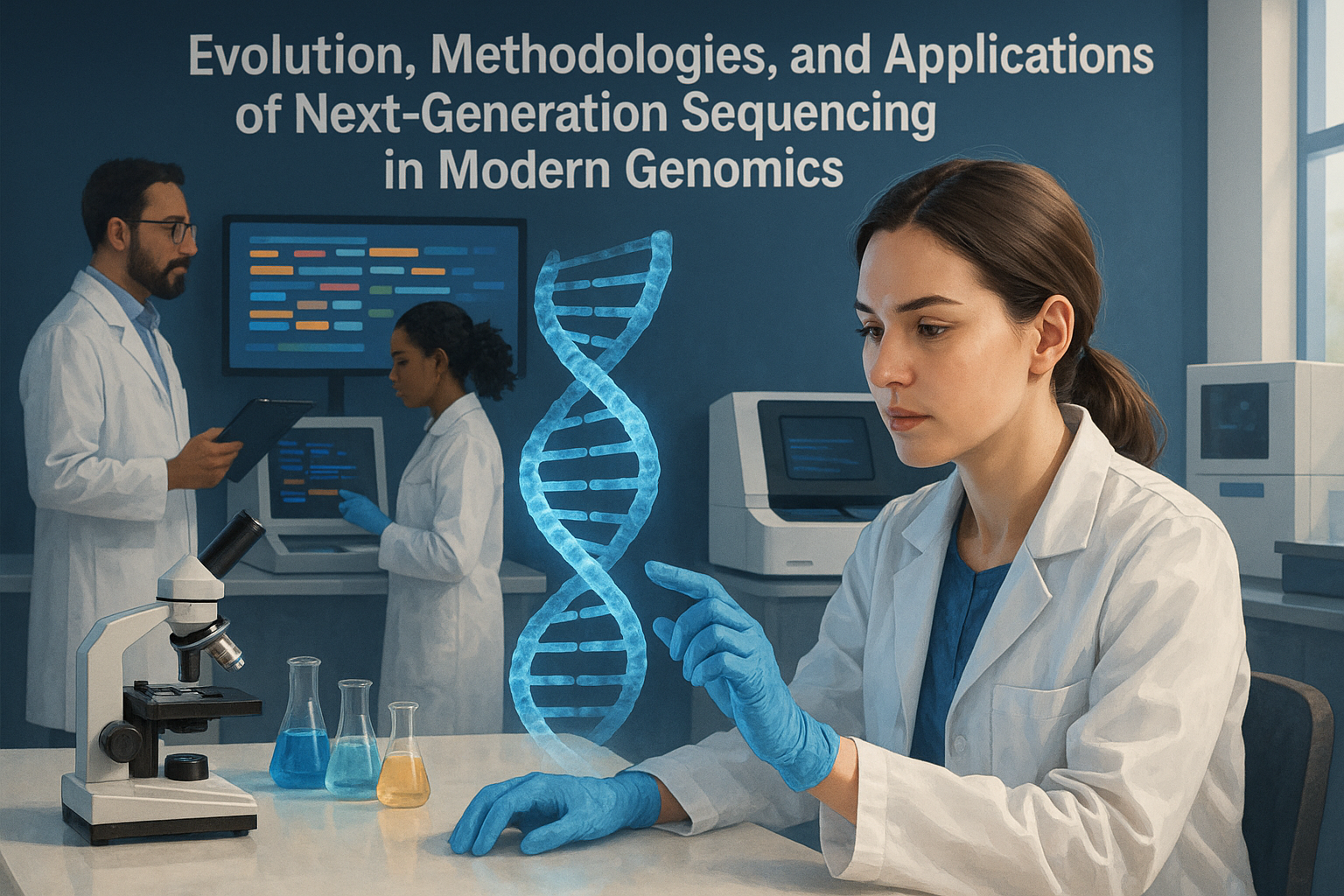Next-Generation Sequencing (NGS), also known as massively parallel sequencing, represents a paradigm shift in molecular biology, enabling high-throughput sequencing of DNA and RNA with exceptional speed, fidelity, and scale. Unlike traditional Sanger sequencing, which is limited to analyzing a single DNA fragment at a time, NGS technologies allow for the simultaneous sequencing of millions to billions of DNA fragments.
This innovation has profoundly impacted fields such as:
- Molecular biology
- Functional genomics
- Transcriptomics
- Epigenomics
- Metagenomics
- Oncogenomics
- Precision treatment
2. History and Milestones in Sequencing Technology
DNA sequencing was pioneered in the 1970s with the Maxam-Gilbert and Sanger sequencing methods.
The latter became the gold standard and laid the foundation for landmark projects such as the Human Genome Project (HGP).
However, due to limitations in throughput, scalability, and cost-efficiency, a need for more robust sequencing technologies arose.
Key Milestones:
- Second-generation sequencing (2GS) introduced in the mid-2000s, with platforms such as Illumina (Solexa), 454 Pyrosequencing, and Ion Torrent, initiated the era of NGS.
- Third-generation sequencing (3GS), allows for long-read sequencing and real-time analysis of native DNA and RNA molecules.
3. Core Principles of the NGS Workflow
Although platforms differ in chemistry and mechanics, most NGS workflows follow a four-step process:
3.1 Library Preparation
This involves:
- Fragmentation of DNA or RNA
- End-repair and A-tailing
- Adapter ligation (platform-specific)
Types of sequencing applications:
- Whole Genome Sequencing (WGS)
- Whole Exome Sequencing (WES)
- RNA-Seq (Transcriptomics)
- ChIP-Seq (Protein-DNA interactions)
- ATAC-Seq (Chromatin accessibility)
- Targeted gene panels
3.2 Template Amplification
- Bridge amplification on a flow cell.
- Ion Torrent and 454 use emulsion PCR (emPCR) on beads.
- Bypassing amplification using single-molecule sequencing.
3.3 Sequencing Chemistry
- Sequencing by Synthesis (SBS) with reversible terminator nucleotides and fluorescence detection.
- Ion Torrent: Detects pH changes from hydrogen ion release.
- ONT: Measures ionic current changes as DNA passes through biological nanopores.
- Using zero-mode waveguides (ZMWs) to detect fluorescent signals in Single-Molecule Real-Time (SMRT) sequencing.
3.4 Bioinformatics and Data Analysis
NGS generates large volumes of data requiring advanced computational pipelines:
- Base calling
- Quality control (FastQC)
- Read alignment (BWA, STAR, Bowtie2)
- Variant calling (GATK, FreeBayes)
- Quantification (HTSeq, featureCounts)
- Differential expression (DESeq2, edgeR)
- Genome assembly and annotation (SPAdes, Trinity, AUGUSTUS)
4. Platform Comparison and Technical Overview
Various next-generation sequencing (NGS) technologies differ in read length, data accuracy, and output capacity, making them suited for distinct types of molecular biology research. Some platforms produce short reads, typically ranging from 150 to 300 base pairs, with high accuracy and are frequently used in broad-scale genomic investigations such as whole-genome surveys and transcriptome analysis. Others generate moderate-length reads between 200 and 400 base pairs with reliable performance, often applied in studies involving defined genomic regions. Long-read sequencing methods can yield fragment sizes from 10 to 25 kilobases with high base-calling precision, offering enhanced resolution for analyzing complex genomic features. There are also systems capable of ultra-long reads extending from 1 kilobase up to several megabases; while their base-level accuracy may vary, they are widely utilized for investigating genome organization and epigenetic features in experimental settings
5. Applications of NGS Technologies
5.1 Transcriptomics and Gene Expression
- RNA-Seq allows detection of mRNA, lncRNA, miRNA, and alternative splicing events.
- Enables understanding of gene regulatory networks and illness-associated transcriptional profiles.
5.2 Epigenomics
- BS-Seq (Bisulfite Sequencing) for DNA methylation
- MeDIP-Seq for methylated DNA enrichment
- ChIP-Seq for histone modifications and transcription factor occupancy
- ATAC-Seq for chromatin accessibility profiling
5.3 Microbiome and Metagenomics
- Shotgun metagenomic sequencing for functional gene content
- 16S/18S rRNA sequencing for taxonomic classification
- Applications in human health, agriculture, and environmental science
5.4 Structural Variant Analysis & Genome Assembly
- Long reads resolve complex repetitive regions, CNVs, inversions, and translocations
- Enables de novo assembly of novel or poorly annotated genomes
5.7 Single-Cell Sequencing
- scRNA-Seq, scATAC-Seq, and CITE-Seq profile transcriptomic, chromatin, and surface protein landscapes at single-cell resolution
- Used in developmental biology, immunology, and tumor heterogeneity studies
6. Challenges and Limitations
Despite remarkable progress, NGS presents challenges:
- Data volume: Requires scalable storage (PB scale)
- Computational load: HPC or cloud-based platforms (e.g., Terra, DNAnexus) are essential
- Cost of analysis: Data generation is affordable, but data processing and interpretation are resource-intensive
- Error profiles: Particularly in ONT—mitigated by HiFi and basecalling algorithms
- Ethical and legal: Consent, privacy, and regulatory compliance are critical in clinical applications
7. Future Perspectives: Multi-Omics and AI Integration
NGS will converge with:
- Multi-omics platforms (e.g., genomics, transcriptomics, proteomics, epigenomics)
- AI/ML-based variant prioritization
- Spatial transcriptomics
- CRISPR-based functional screens
- Real-time sequencing diagnostics via portable nanopore devices
This integrative future will push boundaries in systems biology, personalized treatments, and predictive care.
Next-Generation Sequencing has redefined modern genomics by enabling high-resolution, high-throughput insights into the complexity of life. As platforms continue to evolve toward greater accuracy, speed, and affordability, NGS remains the foundational tool for the advancement of biomedical research, diagnostics, treatment development, and genomic epidemiology.
Mastery of both wet lab protocols and bioinformatics tools is essential to fully leverage the transformative potential of this technology.

